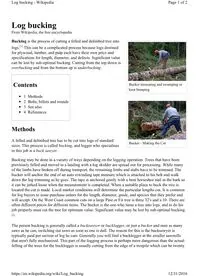
Log Bucking-2016 PDF
Preview Log Bucking-2016
Bucker measuring and swamping or knot bumping Bucker - Making the Cut Log bucking From Wikipedia, the free encyclopedia Bucking is the process of cutting a felled and delimbed tree into logs.[1] This can be a complicated process because logs destined for plywood, lumber, and pulp each have their own price and specifications for length, diameter, and defects. Significant value can be lost by sub-optimal bucking. Cutting from the top down is overbucking and from the bottom up is underbucking. Contents ◾ 1 Methods ◾ 2 Bolts, billets and rounds ◾ 3 See also ◾ 4 References Methods A felled and delimbed tree has to be cut into logs of standard sizes. This process is called bucking, and logger who specialises in this job is a buck sawyer. Bucking may be done in a variety of ways depending on the logging operation. Trees that have been previously felled and moved to a landing with a log skidder are spread out for processing. While many of the limbs have broken off during transport, the remaining limbs and stubs have to be trimmed. The bucker will anchor the end of an auto rewinding tape measure which is attached to his belt and walk down the log trimming as he goes. The tape is anchored gently with a bent horseshoe nail in the bark so it can be jerked loose when the measurement is completed. When a suitable place to buck the tree is located the cut is made. Local market conditions will determine the particular lengths cut. It is common for log buyers to issue purchase orders for the length, diameter, grade, and species that they prefer and will accept. On the West Coast common cuts on a large Pine or Fir tree is three 32's and a 10. There are often different prices for different items. The bucker is the one who turns a tree into logs, and to do his job properly must cut the tree for optimum value. Significant value may be lost by sub-optimal bucking. [2] The person bucking is generally called a bucksawyer or bucklogger, or just a bucker and runs as many saws as he can, switching out saws as soon as one is dull. The reason for this is the bucksawyer is typically paid per section of log he cuts. Generally you will find a bucklogger at the smaller sawmills that aren't fully mechanized. This part of the logging process is perhaps more dangerous than the actual felling of the trees for the bucklogger is usually cutting from the edge of a treepile which can be twenty Page 1 of 2 Log bucking - Wikipedia 12/31/2016 https://en.wikipedia.org/wiki/Log_bucking feet high and as long as there is room to dump them from the truck. Each tree has to be picked out of the pile and cut so that a controlled fall of more trees can be worked as the former fall has been cut and skidded to its respective pile. Bolts, billets and rounds The pieces of bucked logs may be known by several names. Bolts are the pieces of a log which has been bucked into specific lengths which are less than 8 feet (2.4 m),[3] especially short lengths. The etymology of bolt is related to being short and stout and related to knock, and strike possibly because bolts were traditionally split into wood shingles, treenails, clapboards, etc. These pieces may be more specifically known as peeler, shingle, stave or pulpwood bolts.[4] Billet is variously defined as a short piece of round or partially round wood usually a smaller diameter than a block or bolt[4] or as a piece split or cut from a bolt, or sometimes synonymous with bolt, particularly when the pieces are intended as firewood (fuel) and sometimes means a piece of a billet after it has been split. Round is often associated with lengths of un-split firewood. See also ◾ Chain saw ◾ Felling ◾ Hewing ◾ Limbing ◾ Logging References 1. Kauffman, Henry J.. American axes; a survey of their development and their makers,. Brattleboro, Vt.: S. Greene Press, 1972. 109. Print. 2. Weintraub, Andres. Handbook of operations research in natural resources. New York: Springer Science+Business Media, 2007. 379. Print. 3. Chapman, Herman Haupt, and Walter Huber Meyer. Forest Mensuration,. New York: McGraw-Hill, 1949. 13. Print. 4. Dunster, Julian A., and Katherine Jane Dunster. "BILLET", Dictionary of Natural Resource Management. Vancouver, BC: UBC, 1996. 36. Print. Retrieved from "https://en.wikipedia.org/w/index.php?title=Log_bucking&oldid=750480875" Categories: Logging Forestry occupations Lumberjack sports ◾ This page was last modified on 20 November 2016, at 00:36. ◾ Text is available under the Creative Commons Attribution-ShareAlike License; additional terms may apply. By using this site, you agree to the Terms of Use and Privacy Policy. Wikipedia® is a registered trademark of the Wikimedia Foundation, Inc., a non-profit organization. Page 2 of 2 Log bucking - Wikipedia 12/31/2016 https://en.wikipedia.org/wiki/Log_bucking
